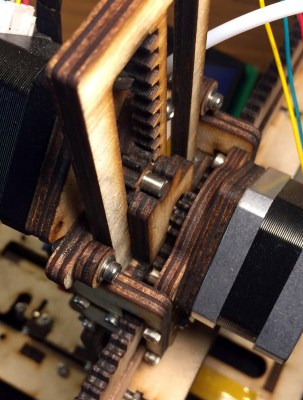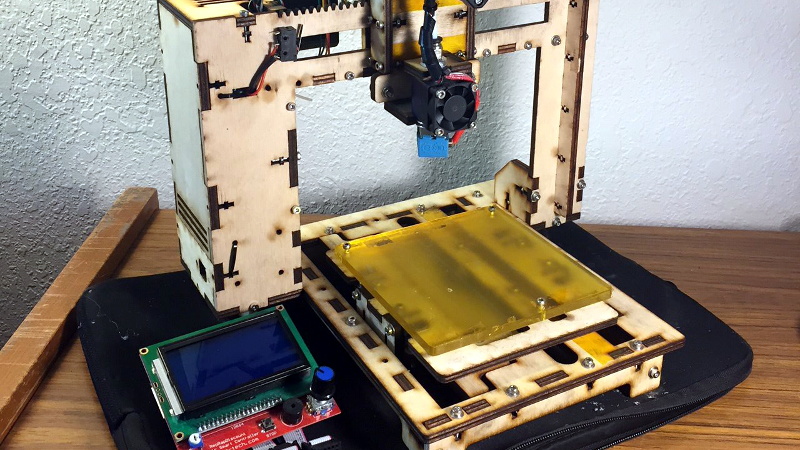About a decade ago, the only way the average hacker was getting their hands on a desktop 3D printer was by building it themselves from a kit. Even then, to keep costs down, many of these kits were made out of laser cut wood. For a few years, wooden printers from companies like MakerBot and PrintrBot were a common sight in particularly well equipped hackerspaces. But as the market expanded and production went up, companies could afford to bend metal and get parts injection molded; the era of the wooden 3D printer was over nearly as soon as it had started.
 But [Luke Wallace] thinks there’s still some life left in the idea. For his entry into the 2019 Hackaday Prize, he’s proposing a revival of the classic laser cut 3D printer kit. But this time, things are a bit different. Today, laser cutters are cheap enough that these kits could conceivably be manufactured at your local hackerspace. With a total bill of materials under $100 USD, these kits could be pumped out for less than the cheapest imports, potentially driving adoption in areas where the current options are too expensive or unavailable.
But [Luke Wallace] thinks there’s still some life left in the idea. For his entry into the 2019 Hackaday Prize, he’s proposing a revival of the classic laser cut 3D printer kit. But this time, things are a bit different. Today, laser cutters are cheap enough that these kits could conceivably be manufactured at your local hackerspace. With a total bill of materials under $100 USD, these kits could be pumped out for less than the cheapest imports, potentially driving adoption in areas where the current options are too expensive or unavailable.
Of course, just a laser cut wood frame wouldn’t be enough to break the fabled $100 barrier. To drive the cost down even farther, [Luke] has redesigned essentially every component so it could be made out of wood. If its not electronic, there’s a good chance its going to be cut out of the same material the frame is made out of. Probably the biggest change is that the traditional belt and pulley system has been replaced with rack and pinion arrangements.
After cutting all the pieces, essentially all you need to provide is the stepper motors, a RAMPS controller, the hotend, and the extruder. He’s even got a design for a laser cut wood extruder if you want to go back to the real olden days and save yourself another few bucks. Or skip the LCD controller and just run it over USB.
But what do the prints look like? [Luke] has posted a few pictures of early test pieces on the project’s Hackaday.io page, and to be honest, they’re pretty rough. But they don’t look entirely unlike the kind of prints you’d get on one of those early printers before you really got it dialed in, so we’re interested in seeing how the results improve with further refinements and calibration. (Editor’s note: Since writing this, he got backlash compensation up and running, and it looks a ton better already. Very impressive for something running on wooden gears!)




















Given that there’s more” low-angle step” stepper motors on the market now, it seems obvious to go down the route of rack&pinion or similar if mechanical slack is eliminated.
I’ve been considering piecing together a 3d printer from an old scanner and printer, just hacking it together as I learn how 3d printing works. This is definitely inspirational :)
It depresses me looking into DIY printer builds these days, the old quick and dirty spirit has gone, current discussions are like “You’re a complete idiot if you do it that way and it won’t even work at all” meanwhile 5 years ago, everyone did it that way. I get it, new shiny parts are better, but everyone is so eager to spend your money for you. Ask how to make a printer for $100ish and by the time the feature creepers and “can’t possibly do it any way but mine” experts are done with you, it’s a $1000 jobbie.
This attitude is pervasive across many technical hobbies, including the motorsports kind. Every time I see somebody ask “What soldering iron should I get?” I see these very assertive responses like “You’re wasting your money if you spend less than $100 on a soldering station with temperature control and a built in bidet.” Uh, I do everything with a soldering iron that you can buy with all the accessories for $20! Yes, the $100 station is nicer. But not $80 nicer. I’d rather spend that $80 on parts and kits!
The DIY mentality is being slowly replaced with a consumer mentality. Why build when you can buy so cheaply? Because you can- and you learn something in the process. And maybe it’s just good enough for your needs. Case in point: I built a recumbent bicycle from bike parts and square tubing. I built a MOT based welder to do it. Plain jane A/C welder running on 120v. It could easily be dismissed as simply a toy, and it IS compared to a Big Boy welder that needs 220V 50A to run. But it’s perfect for its use and its simplicity forces you to learn how welding works.
People need to stop buying and start building, just like this fellow did.
[rant mode off]
“including the motorsports kind”
Very much so. These days I dont post much about what I do in that area as armchair internet folks are too readily telling me how it’s going to fail
Meanwhile insta fanboys are posting how much money they have with a shopping list of parts & getting likes, which is considered by many to mean they are doing the right thing….
It’s fun to destroy them at the track in my PoS and then refuse to open the bonnet :)
Indeed. As much as I like the idea of overlanding, the whole overlanding movement is all about status and how much time and money you spent on vehicles that spend more time on instagram than off-road.
Just loved the first comments from RW ver 0.0.1, geocrasher and dave, not much to add, just wanted to say thanks; thanks for saying all that without adding to the hate we see around (sometimes even here, sadly).
You can get a Chinese temperature controlled hotair reflow + iron combo for $50 these days.
I had used a $10 Goot temperature controlled iron with a PTC heating element back in the early 80’s.
Unless you are very skilled in soldering or rarely do fine pitched soldering, there isn’t much of a macho point of using $20 one.
FYI: not the same model, but under $10 Canadian
https://picclick.ca/60W-Adjustable-Temperature-Controlled-Welding-Soldering-Iron-110V-220V-142682355155.html
Yup that’s the very one I use. Works great. It does what I need, and that’s the point- it does what I need. Something else might open more doors, sure, but if I’m just starting out or don’t have a *specific* need for something better, this works just fine.
a bidet you say?
In Europe you can laser cut a 3D printer frame for 70€ ( im sorry fir USA users if steel is damn expensive at moment before them) the performance are even not comparable to an wood frame (or even to an famous aluminum frame ).
You can find the cutting plans on thingiverse for free under a CC licence.
Where can you get that for that price?
I love it. It’s pretty :D (I love my wooden Ultimaker as well)
But I don’t think the economics work. At Ultimaker with the Ultimaker Original+ we actually moved to more injection molded parts compared to wooden parts as that saved a bit of cost on the total part count, and made assembly much less complex.
i bought a chinese makerbot clone and used it for parts, as i couldnt really use it for anything else because the print bed was tiny as hell. the amount of nuts and screws was maddening. i still have the case, and all the parts, not sure what im gonna use it for but it was neat. interestingly, it had a 220v pc power supply.